Achieving a Near-Infrared Absorption by A−DA’D−A Type Isoindigo-Based Small Molecular Acceptors for Organic Photovoltaics
Abstract
1. Introduction
2. Results and Discussion
2.1. Synthesis and Characterization
2.2. Optical and Electrochemical Properties
2.3. Photovoltaic Performances and Mechanism Study
3. Conclusions
Supplementary Materials
Author Contributions
Funding
Institutional Review Board Statement
Informed Consent Statement
Data Availability Statement
Conflicts of Interest
References
- Shen, Q.; He, C.L.; Li, S.X.; Zuo, L.J.; Shi, M.; Chen, H.Z. Design of Non-fused Ring Acceptors toward High-Performance, Stable, and Low-Cost Organic Photovoltaics. Acc. Mater. Res. 2022, 3, 644–657. [Google Scholar] [CrossRef]
- Armin, A.; Li, W.; Sandberg, O.J.; Xiao, Z.; Ding, L.; Nelson, J.; Neher, D.; Vandewal, K.; Shoaee, S.; Wang, T. A History and Perspective of Non-Fullerene Electron Acceptors for Organic Solar Cells. Adv. Energy Mater. 2021, 11, 20003570. [Google Scholar] [CrossRef]
- Mazzio, K.A.; Luscombe, C.K. The future of organic photovoltaics. Chem. Soc. Rev. 2015, 44, 78–90. [Google Scholar] [CrossRef]
- Luo, D.; Jang, W.; Babu, D.D.; Kim, M.S.; Wang, D.H.; Kyaw, A.K.K. Recent progress in organic solar cells based on non-fullerene acceptors: Materials to devices. J. Mater. Chem. A 2022, 10, 3255–3295. [Google Scholar] [CrossRef]
- Yang, M.; Wei, W.; Zhou, X.; Wang, Z.; Duan, C. Non-fused ring acceptors for organic solar cells. Energy Mater. 2021, 1, 100008. [Google Scholar] [CrossRef]
- Li, Y.; Huang, W.; Zhao, D.; Wang, L.; Jiao, Z.; Huang, Q.; Wang, P.; Sun, M.; Yuan, G. Recent Progress in Organic Solar Cells: A Review on Materials from Acceptor to Donor. Molecules 2022, 27, 1800. [Google Scholar] [CrossRef] [PubMed]
- Zhang, J.; Tan, H.S.; Guo, X.; Facchetti, A.; Yan, H. Material insights and challenges for non-fullerene organic solar cells based on small molecular acceptors. Nat. Energy 2018, 3, 720–731. [Google Scholar] [CrossRef]
- Cheng, P.; Li, G.; Zhan, X.; Yang, Y. Next-generation organic photovoltaics based on non-fullerene acceptors. Nat. Photonics 2018, 12, 131–142. [Google Scholar] [CrossRef]
- Hou, J.; Inganas, O.; Friend, R.H.; Gao, F. Organic solar cells based on non-fullerene acceptors. Nat. Mater. 2018, 17, 119–128. [Google Scholar] [CrossRef]
- Bi, P.; Zhang, S.; Chen, Z.; Xu, Y.; Cui, Y.; Zhang, T.; Ren, J.; Qin, J.; Hong, L.; Hao, X. Reduced non-radiative charge recombination enables organic photovoltaic cell approaching 19% efficiency. Joule 2021, 5, 2408–2419. [Google Scholar] [CrossRef]
- Cui, Y.; Xu, Y.; Yao, H.; Bi, P.; Hong, L.; Zhang, J.; Zu, Y.; Zhang, T.; Qin, J.; Ren, J. Single-junction organic photovoltaic cell with 19% efficiency. Adv. Mater. 2021, 33, 2102420. [Google Scholar] [CrossRef] [PubMed]
- Wang, J.; Zhan, X. Fused-ring electron acceptors for photovoltaics and beyond. Acc. Chem. Res. 2021, 54, 132–143. [Google Scholar] [CrossRef]
- Chen, Y.N.; Li, M.; Wang, Y.; Wang, J.; Zhang, M.; Zhou, Y.; Yang, J.; Liu, Y.; Liu, F.; Tang, Z.; et al. A fully non-fused ring acceptor with planar backbone and near-IR absorption for high performance polymer solar cells. Angew. Chem. Int. Ed. 2020, 59, 22714–22720. [Google Scholar] [CrossRef] [PubMed]
- Jiang, B.H.; Chen, Y.S.; You, Y.C.; Su, Y.W.; Chang, C.Y.; Shi, H.S.; Shi, Z.E.; Chen, C.P.; Wong, K.T. The role of unfused-ring-based small-molecule acceptors as the third component in ternary organic photovoltaics. J. Mater. Chem. C 2024, 12, 12004–12014. [Google Scholar] [CrossRef]
- Zhou, Y.; Li, M.; Lu, H.; Jin, H.; Wang, X.; Zhang, Y.; Shen, S.; Ma, Z.; Song, J.; Bo, Z. High-Efficiency Organic Solar Cells Based on a Low-Cost Fully Non-Fused Electron Acceptor. Adv. Funct. Mater. 2021, 31, 2101742. [Google Scholar] [CrossRef]
- Liu, Y.; Song, J.; Bo, Z. Designing high performance conjugated materials for photovoltaic cells with the aid of intramolecular noncovalent interactions. Chem. Commun. 2021, 57, 302–314. [Google Scholar] [CrossRef]
- Zhang, X.; Qin, L.; Yu, J.; Li, Y.; Wei, Y.; Liu, X.; Lu, X.; Gao, F.; Huang, H. High-performance noncovalently fused-ring electron acceptors for organic solar cells enabled by noncovalent intramolecular interactions and end-group engineering. Angew. Chem. Int. Ed. 2021, 60, 12475–12481. [Google Scholar] [CrossRef]
- Li, S.; Zhan, L.; Liu, F.; Ren, J.; Shi, M.; Li, C.-Z.; Russell, T.P.; Chen, H. An unfused-core-based nonfullerene acceptor enables high-efficiency organic solar cells with excellent morphological stability at high temperatures. Adv. Mater. 2018, 30, 1705208. [Google Scholar] [CrossRef]
- Ma, L.; Zhang, S.; Zhu, J.; Wang, J.; Ren, J.; Zhang, J.; Hou, J. Completely non-fused electron acceptor with 3D-interpenetrated crystalline structure enables efficient and stable organic solar cell. Nat. Commun. 2021, 12, 5093. [Google Scholar] [CrossRef] [PubMed]
- Wang, Y.; Liu, Z.; Cui, X.; Wang, C.; Lu, H.; Liu, Y.; Fei, Z.; Ma, Z.; Bo, Z. Small molecule acceptors with a ladder-like core for high-performance organic solar cells with low non-radiative energy losses. J. Mater. Chem. A 2020, 8, 12495–12501. [Google Scholar] [CrossRef]
- Zhao, J.; Xu, X.; Yu, L.; Li, R.; Li, Y.; Peng, Q. Highly Efficient Non-Fused-Ring Electron Acceptors Enabled by the Conformational Lock and Structural Isomerization Effects. ACS Appl. Mater. Interfaces 2021, 13, 25214–25223. [Google Scholar] [CrossRef]
- Yu, H.; Qi, Z.; Li, X.; Wang, Z.; Zhou, W.; Ade, H.; Yan, H.; Chen, K. Modulating Energy Level on an A−D−A’−D−A-Type Unfused Acceptor by a Benzothiadiazole Core Enables Organic Solar Cells with Simple Procedure and High Performance. Sol. RRL 2020, 4, 2000421. [Google Scholar] [CrossRef]
- Huang, H.; Guo, Q.; Feng, S.; Zhang, C.; Bi, Z.; Xue, W.; Yang, J.; Song, J.; Li, C.; Xu, X. Noncovalently fused-ring electron acceptors with near-infrared absorption for high-performance organic solar cells. Nat. Commun. 2019, 10, 3038. [Google Scholar] [CrossRef]
- Li, S.; Zhan, L.; Zhao, W.; Zhang, S.; Ali, B.; Fu, Z.; Lau, T.-K.; Lu, X.; Shi, M.; Li, C.-Z. Revealing the effects of molecular packing on the performances of polymer solar cells based on A−D−CD−A type non-fullerene acceptors. J. Mater. Chem. A 2018, 6, 12132–12141. [Google Scholar] [CrossRef]
- Li, S.; Zhan, L.; Lau, T.; Yu, Z.; Yang, W.; Andersen, T.R.; Fu, Z.; Li, C.; Lu, X.; Shi, M.; et al. Near-Infrared Nonfullerene Acceptors Based on Benzobis(thiazole) Unit for Efficient Organic Solar Cells with Low Energy Loss. Small Methods 2019, 3, 1900531. [Google Scholar] [CrossRef]
- Liu, X.; Wei, Y.; Zhang, X.; Qin, L.; Wei, Z.; Huang, H. An A−D−A’−D−A type unfused nonfullerene acceptor for organic solar cells with approaching 14% efficiency. Sci. Chin. Chem. 2021, 64, 228–231. [Google Scholar] [CrossRef]
- Stalder, R.; Mei, J.; Graham, K.R.; Estrada, L.A.; Reynolds, J.R. Isoindigo, a versatile electron-deficient unit for high-performance organic electronics. Chem. Mater. 2014, 26, 664–678. [Google Scholar] [CrossRef]
- Wang, T.; Chen, Y.; Bao, X.; Du, Z.; Guo, J.; Wang, N.; Sun, M.; Yang, R. A new isoindigo-based molecule with ideal energy levels for solution-processable organic solar cells. Dyes Pigments 2013, 98, 11–16. [Google Scholar] [CrossRef]
- Mei, J.; Graham, K.R.; Stalder, R.; Reynolds, J.R. Synthesis of isoindigo-based oligothiophenes for molecular bulk heterojunction solar cells. Org. Lett. 2010, 12, 660–663. [Google Scholar] [CrossRef] [PubMed]
- Guo, W.; Liu, H.; Liu, J.; Zhang, J.; Cao, Y.; Yang, Z.; Liu, Y.; Wu, Z.; Song, X.; Niu, Y. The influence of fluorinated position on the performance of isoindigo-based polymer solar cells. Synth. Met. 2021, 277, 116768. [Google Scholar] [CrossRef]
- Lim, D.-H.; Ha, J.-W.; Choi, H.; Yoon, S.C.; Lee, B.R.; Ko, S.-J. Recent progress of ultra-narrow-bandgap polymer donors for NIR-absorbing organic solar cells. Nanoscale Adv. 2021, 3, 4306–4320. [Google Scholar] [CrossRef]
- Patil, H.; Chang, J.; Gupta, A.; Bilic, A.; Wu, J.; Sonar, P.; Bhosale, S.V. Isoindigo-Based Small Molecules with Varied Donor Components for Solution-Processable Organic Field Effect Transistor Devices. Molecules 2015, 20, 17362–17377. [Google Scholar] [CrossRef]
- Miao, J.; Meng, B.; Liu, J.; Wang, L. An A−D−A’−D−A type small molecule acceptor with a broad absorption spectrum for organic solar cells. Chem. Commun. 2018, 54, 303–306. [Google Scholar] [CrossRef]
- Zhang, G.; Zhao, J.; Chow, P.C.Y.; Jiang, K.; Zhang, J.; Zhu, Z.; Zhang, J.; Huang, F.; Yan, H. Nonfullerene Acceptor Molecules for Bulk Heterojunction Organic Solar Cells. Chem. Rev. 2018, 118, 3447–3507. [Google Scholar] [CrossRef]
- Wang, X.; Li, Y.; Li, J.; Zhang, Y.; Shao, J.; Li, Y. Direct Arylation Synthesis of Small Molecular Acceptors for Organic Solar Cells. Molecules 2023, 28, 3515. [Google Scholar] [CrossRef] [PubMed]
- Yemene, A.E.; Venkatraman, V.; Almenningen, D.M.; Hoff, B.H.; Gautun, O.R. Synthesis of Novel 3,6-Dithienyl Diketopyrrolopyrrole Dyes by Direct C−H Arylation. Molecules 2020, 25, 2349. [Google Scholar] [CrossRef]
- Liu, H.; Tao, Y.-D.; Wang, L.-H.; Ye, D.-N.; Huang, X.-M.; Chen, N.; Li, C.-Z.; Liu, S.-Y. C−H Direct Arylation: A Robust Tool to Tailor the π−Conjugation Lengths of Non-Fullerene Acceptors. ChemSusChem 2022, 15, e202200034. [Google Scholar] [CrossRef] [PubMed]
- Wu, Y.; He, X.-Y.; Huang, X.-M.; Yang, L.-J.; Liu, P.; Chen, N.; Li, C.-Z.; Liu, S.-Y. Synthesis of Long Chain Oligomeric Donor and Acceptors via Direct Arylation for Organic Solar Cells. Chin. J. Chem. 2024, 42, 523–532. [Google Scholar] [CrossRef]
- Tan, Z.-R.; Xing, Y.-Q.; Cheng, J.-Z.; Zhang, G.; Shen, Z.-Q.; Zhang, Y.-J.; Liao, G.; Chen, L.; Liu, S.-Y. EDOT-based conjugated polymers accessed via C−H direct arylation for efficient photocatalytic hydrogen production. Chem. Sci. 2022, 13, 1725–1733. [Google Scholar] [CrossRef]
- Liu, H.; Chen, Y.; Chen, N.; Liu, S.-Y. Stepwise Extended π−Conjugation Lengths of Chlorinated Oligomeric Non-fullerene Acceptors Accessed via Direct C−H Arylation. Acta Polym. Sin. 2023, 54, 1122–1130. [Google Scholar]
- Runge, E.; Gross, E.K.U. Density-functional theory for time-dependent systems. Phys. Rev. Lett. 1984, 52, 997–1000. [Google Scholar] [CrossRef]
- Mourik, T.V.; Bühl, M.; Gaigeot, M.-P. Density functional theory across chemistry, physics and biology. Philos. Trans. R. Soc. A 2011, 372, 20120488. [Google Scholar] [CrossRef]
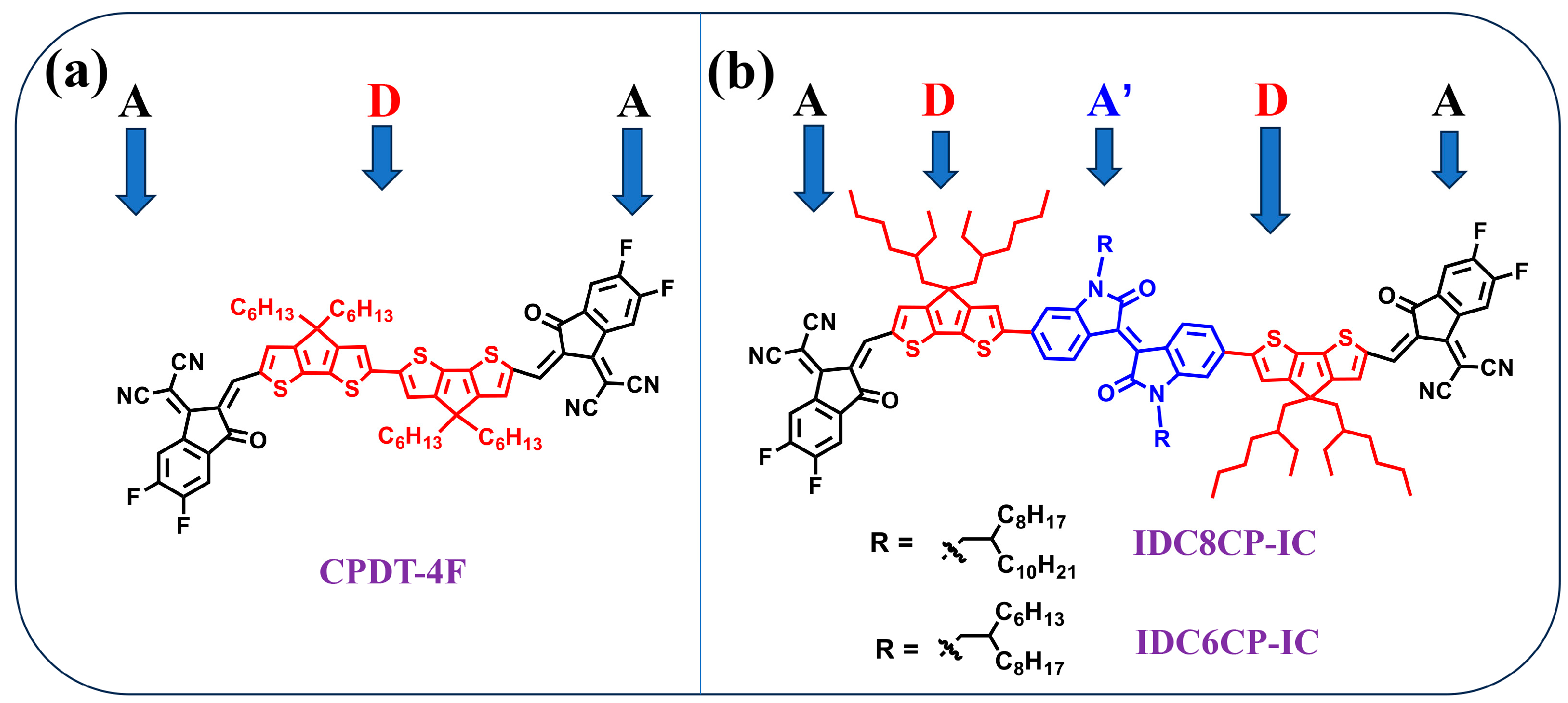


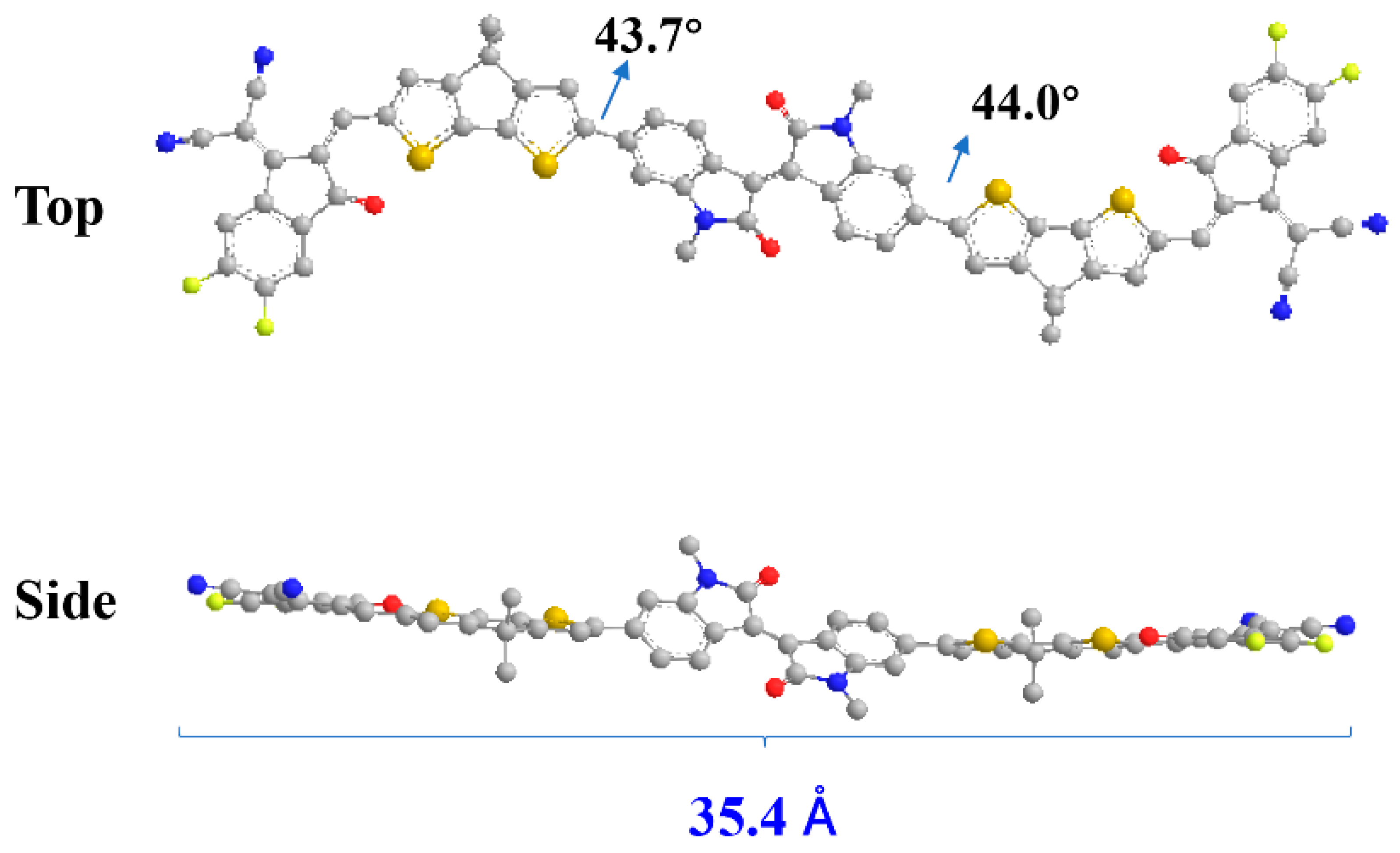
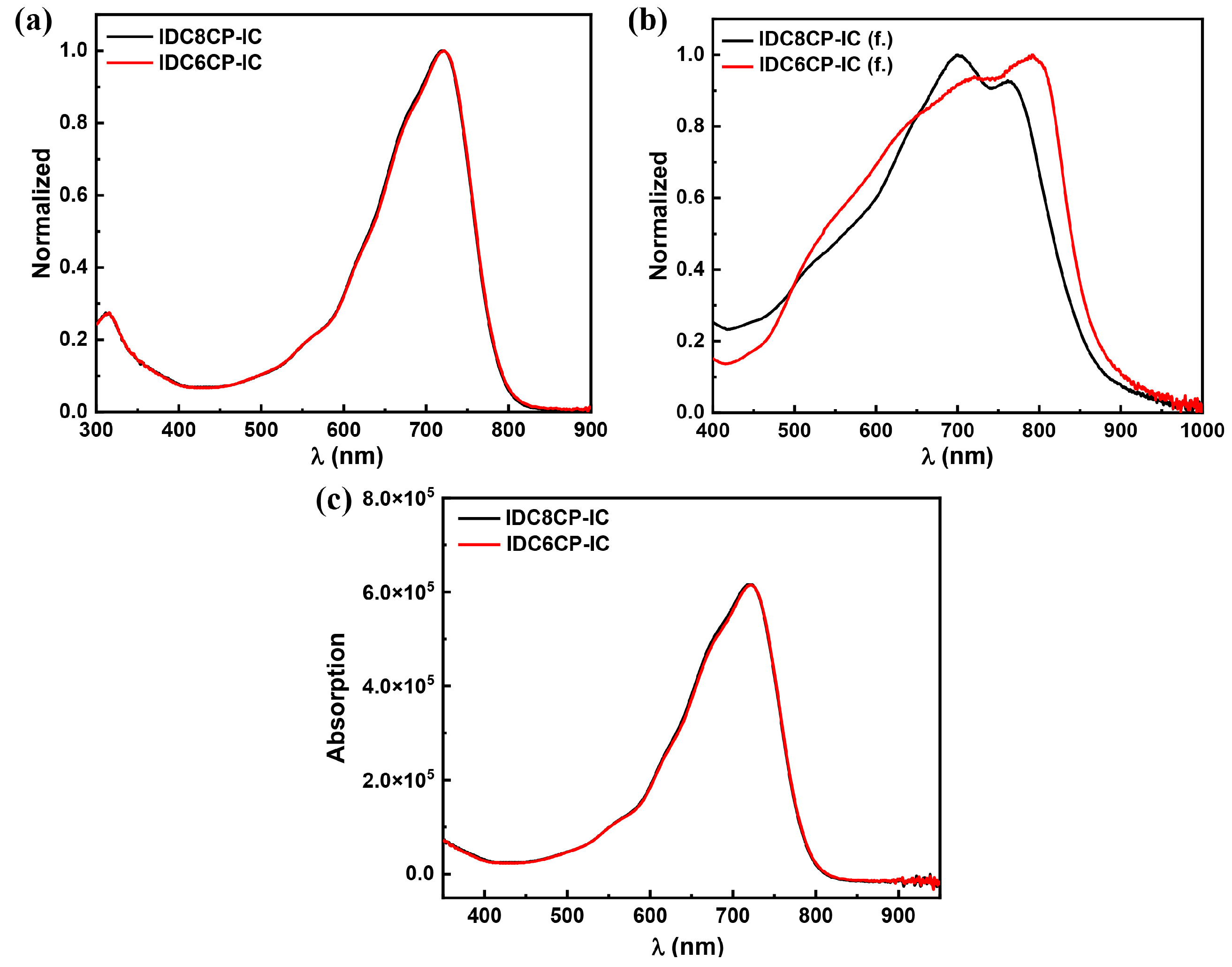
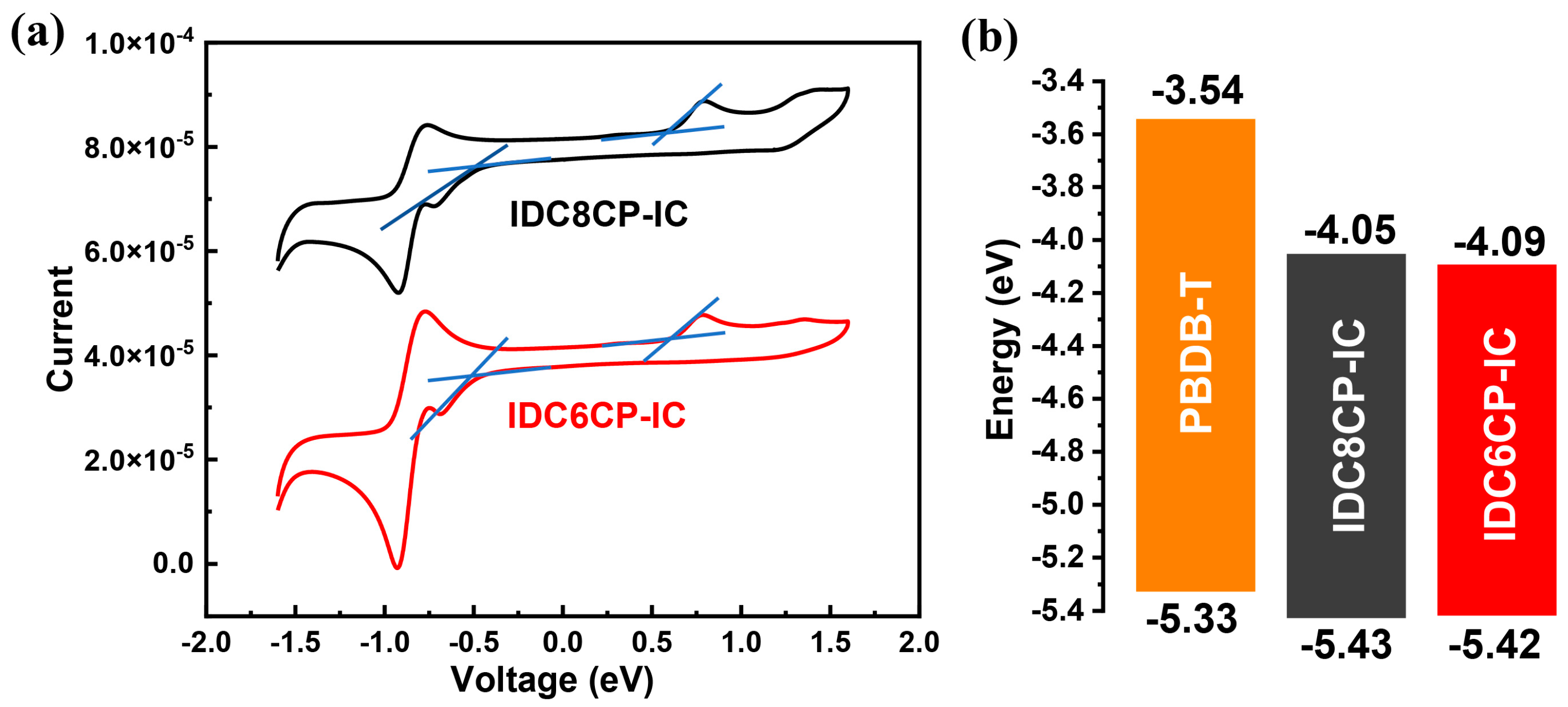
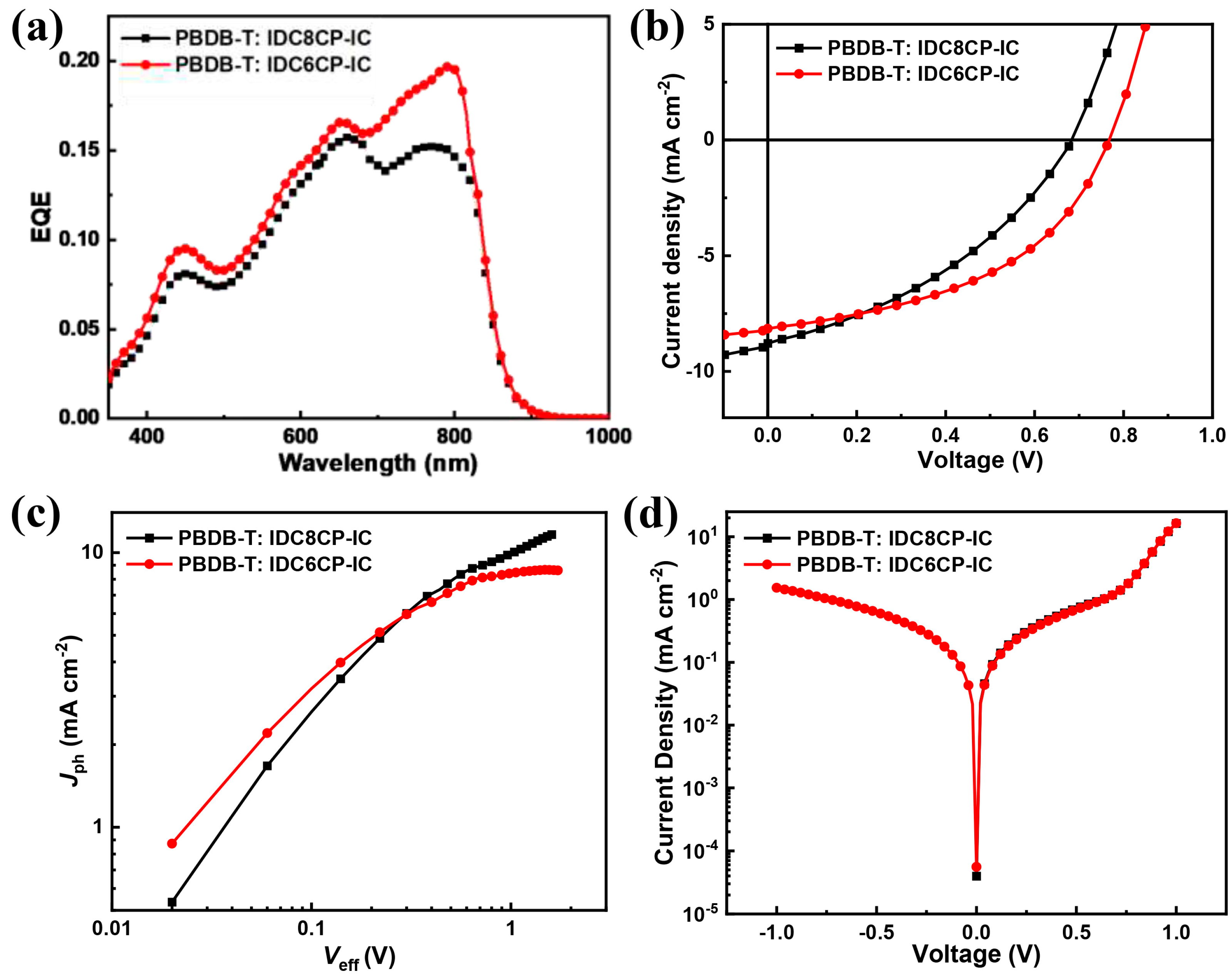
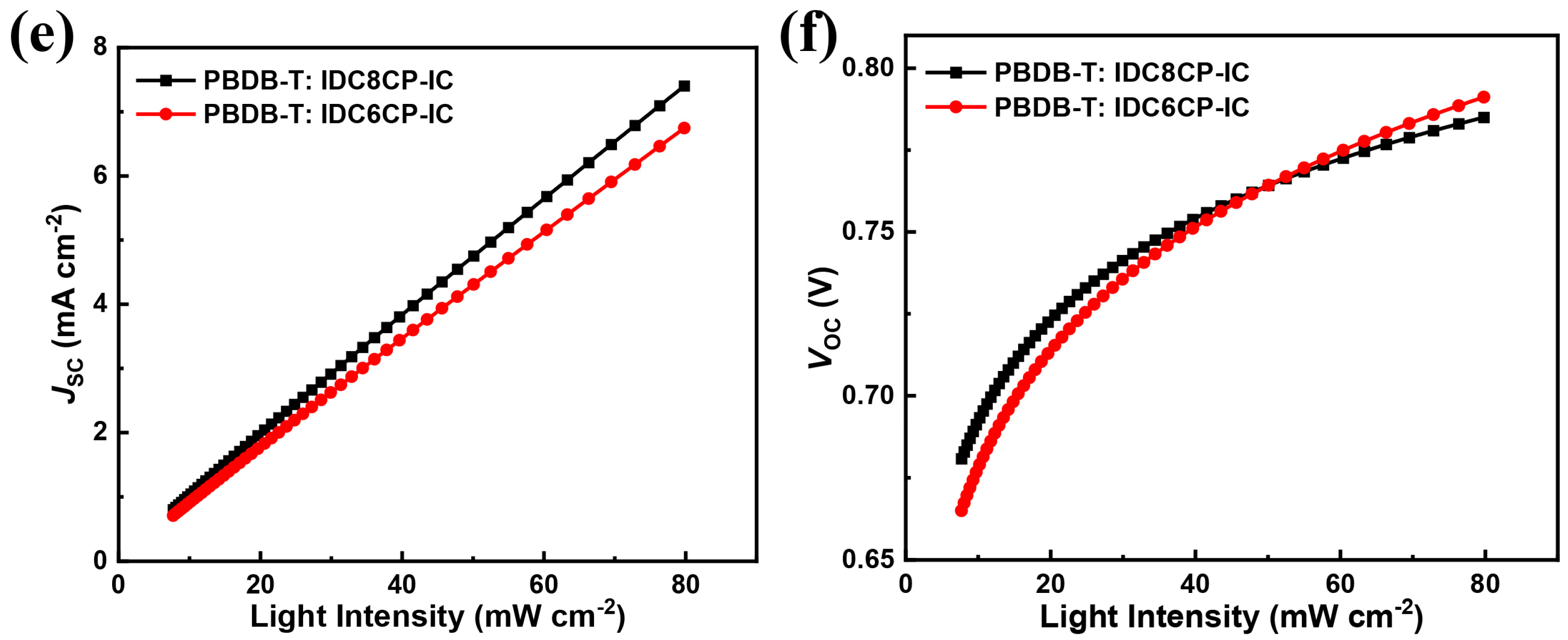
| Acceptors | λmaxs (nm) | λmaxf (nm) | λonsetf (nm) | ε (M−1 cm−1) | Egopt (eV) | HOMO (eV) | LUMO (eV) |
|---|---|---|---|---|---|---|---|
| IDC8CP-IC | 720.5 | 700.0, 761.5 | 900.0 | 6.16 × 105 | 1.38 | −5.43 | −4.05 |
| IDC6CP-IC | 721.5 | 720.0, 789.5 | 930.0 | 6.15 × 105 | 1.33 | −5.42 | −4.09 |
| BHJs | VOC (V) | JSC (mA cm−2) | FF (%) | PCE (%) | μh (×10−5 cm2V−1s−1) | μe (×10−5 cm2V−1s−1) |
|---|---|---|---|---|---|---|
| PBDB-T:IDC8CP-IC | 0.68 | 8.79 | 37.60 | 2.36 | 1.22 ± 0.01 | 2.88 ± 0.01 |
| PBDB-T:IDC6CP-IC | 0.77 | 8.15 | 46.10 | 3.10 | 1.62 ± 0.01 | 3.48 ± 0.02 |
Disclaimer/Publisher’s Note: The statements, opinions and data contained in all publications are solely those of the individual author(s) and contributor(s) and not of MDPI and/or the editor(s). MDPI and/or the editor(s) disclaim responsibility for any injury to people or property resulting from any ideas, methods, instructions or products referred to in the content. |
© 2025 by the authors. Licensee MDPI, Basel, Switzerland. This article is an open access article distributed under the terms and conditions of the Creative Commons Attribution (CC BY) license (https://creativecommons.org/licenses/by/4.0/).
Share and Cite
Liu, H.; Wu, Y.; Ye, D.-N.; Chen, N.; Huang, X.-M.; Liu, S.-Y. Achieving a Near-Infrared Absorption by A−DA’D−A Type Isoindigo-Based Small Molecular Acceptors for Organic Photovoltaics. Molecules 2025, 30, 344. https://doi.org/10.3390/molecules30020344
Liu H, Wu Y, Ye D-N, Chen N, Huang X-M, Liu S-Y. Achieving a Near-Infrared Absorption by A−DA’D−A Type Isoindigo-Based Small Molecular Acceptors for Organic Photovoltaics. Molecules. 2025; 30(2):344. https://doi.org/10.3390/molecules30020344
Chicago/Turabian StyleLiu, Hui, Yu Wu, Dong-Nai Ye, Na Chen, Xu-Min Huang, and Shi-Yong Liu. 2025. "Achieving a Near-Infrared Absorption by A−DA’D−A Type Isoindigo-Based Small Molecular Acceptors for Organic Photovoltaics" Molecules 30, no. 2: 344. https://doi.org/10.3390/molecules30020344
APA StyleLiu, H., Wu, Y., Ye, D.-N., Chen, N., Huang, X.-M., & Liu, S.-Y. (2025). Achieving a Near-Infrared Absorption by A−DA’D−A Type Isoindigo-Based Small Molecular Acceptors for Organic Photovoltaics. Molecules, 30(2), 344. https://doi.org/10.3390/molecules30020344







